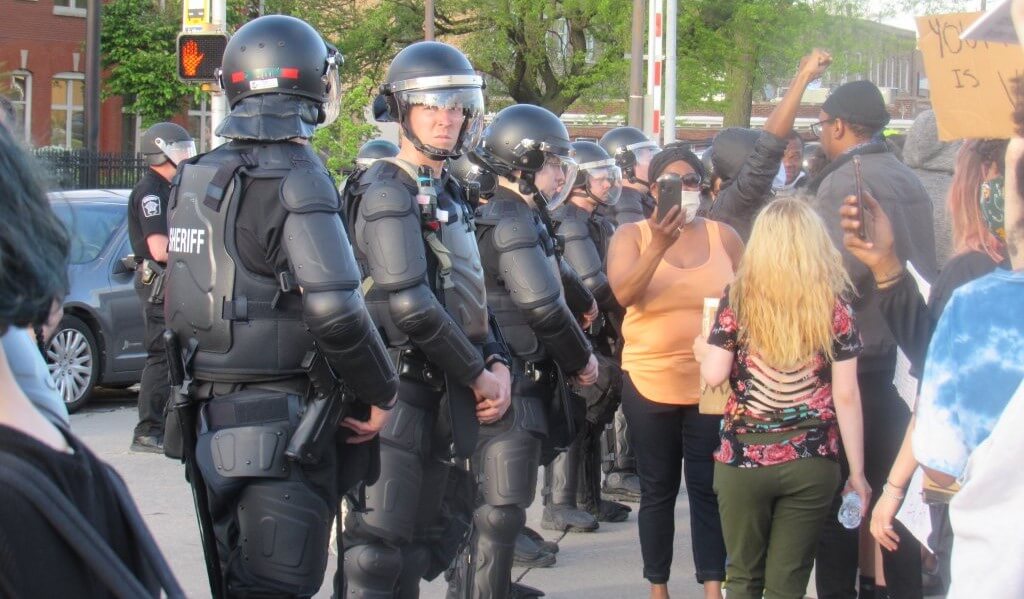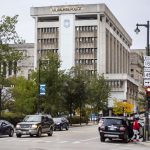Emails Show Local Law Enforcement Coordinating Protest Response
Email group also shared intelligence among local police departments and with FBI.

Protesters confronting riot-clad officers who are blocking the freeway on the first day. Photo by Isiah Holmes/Wisconsin Examiner.
Last year, as the streets in towns across Wisconsin filled with marches against police violence, local law enforcement agencies established numerous ways of sharing updates and information on the protests. One response was the Milwaukee County Law Enforcement Executives COVID/Protest group, which became an online hub for local agencies monitoring the movements of protesters in 2020.
Wisconsin Examiner obtained emails sent within the Google group through an open records request to the Milwaukee County Sheriff’s Office. Specifically, the request asked for emails within the inbox of Sheriff Earnell Lucas.
The Milwaukee County Sheriff Office didn’t respond to a request for comment for this story. Chief William Jessup of the South Milwaukee Police Department, however, offered some insights into the group’s creation and purpose. Jessup told Wisconsin Examiner that once the protests began, “We used the same Google group to exchange information and coordinate plans.” Jessup was also president of the Milwaukee County Law Enforcement Executives’ Association (MCLEETA) and helped “coordinate information exchanges and virtual meetings with other chiefs, often using Google group.”
Jessup’s name appears frequently in the group’s emails, among many other law enforcement leaders, including chiefs, supervisors, and other personnel from the police departments of Milwaukee, Oak Creek, St. Francis, West Allis, Wauwatosa, Marquette University, and other municipalities. Personnel from the Federal Bureau of Investigations (FBI), Milwaukee’s intelligence fusion center, and related national security offices also sent messages.
The emails offer a glimpse of the activities and attitudes of many agencies involved in protest enforcement. On June 1, 2020 a few days after Milwaukee’s protests began, Jessup sent an email out to the Google group. “If you haven’t received the HSIN link to monitor the events during the protests, please send an email to Captain Craig Sarnow at the Fusion Center and he will add you to his list,” wrote Jessup. “As we discussed in the call, if you have an active protest in your city with live video, the Fusion center can walk you through the steps to connect your video to the HISN.” These links essentially act as secure portals for law enforcement officials to communicate and access information. These are monitored by the Fusion Center and other entities.
Jessup sent another email on June 1 mentioning the FBI’s growing interest in Milwaukee’s protests. “As we discussed in our call, the FBI is asking for our assistance in collecting some information about injuries, arrests, and property damage during the course of the protests.” A data sheet was attached to the email, but wasn’t provided as part of the records request. During Milwaukee’s first protest night, officers fired less-lethal munitions at protesters. Later that night as the crowds dispersed some businesses were damaged and had goods stolen.
When asked about why agencies were looking for certain information on the protests Jessup recalled that, “we had a virtual meeting (group call) to plan for the ongoing protests and someone on the call asked the group for information regarding injured officers, damaged government equipment, and arrests.” He added that, “I don’t recall who asked for the information but I believe it was being collected to provide information to the public and to elected officials.”
Some emails, however, suggest an interest in steering the narrative around the city’s protests. On June 3, 2020, Jessup emailed, “As we discussed in our call, law enforcement will need to provide context to the community regarding the protests and the violent nature of some protesters. Please provide the Fusion Center with any video/photos of damage to government property, assaults on officers, and injuries sustained by our personnel. In addition, please provide the Fusion Center with any protest-related arrest information on a daily basis so they can provide that information to the FBI.” Part of Fusion, called the Southeastern Threat Analysis Center (STAC), hosts a partnership with the Department of Homeland Security (DHS) and the FBI’s Joint Terrorism Task Force.
As Milwaukee’s Common Council probed Milwaukee PD’s gear, the department began pushing back. Then-Chief Alfonso Morales famously compared criticism of police actions to Christ’s crucifixion. On June 4, West Allis’ police chief sent an email with the subject line: “Getting Our Message Out.” Chief Patrick Mitchell discussed suggestions he’d received regarding hiring a public relations firm and that the idea had backing from Morales and lobbyists from the Wisconsin Chiefs of Police Association. “They are in agreement that this is a state-wide need,” Mitchell wrote.
Milwaukee PD would also claim it deployed tear gas and rubber bullets in broad daylight, and before a curfew, to counter of what it said were Molotov Cocktails. Subsequent investigations showed that what police claimed was a firebomb was actually just a plastic water bottle.
Heads of local departments also communicated about specific protesters. In an email sent on June 4, 2020, St. Francis PD’s Chief Kevin Hunter provided an update on a protest held by local resident Bethany Crevensten. She’d planned a small protest outside the home of someone who allegedly made racist comments regarding owning Black people. That individual was also on parole at the time, Chief Hunter noted, adding, “this will not stop Bethany according to our conversation with her today, but again, sounds like it will be peaceful.” A screenshot of a social media post made by Crevenseten to announce the protest was also attached to the email.
Like dozens of other protesters, elected officials, and one journalist, Crevensten was also placed on a list by police. The list, created by a Wauwatosa Police Department crime analyst last summer and shared with the FBI and numerous other agencies, was both called a “protester list” and a “target list” by the analyst. While that list focuses on a specific group of protesters known as The People’s Revolution, it also includes activists from across Milwaukee.
Jessup told Wisconsin Examiner that his department did not receive the list from Wauwatosa PD. Emails in the Google group also included updates and information on a wide variety of left-wing protest events. He also stated that, “I don’t recall any discussion regarding specific protesters. Law enforcement’s goal was simply to have context when answering questions about injuries, damage, and arrests.”
On June 9, 2020, Oak Creek PD’s Chief Steve Anderson sent out an email requesting details on a small demonstration. “Somebody is organizing a planned chalk event demonstration at our Drexel Town Square this week Thursday,” said Anderson. “I am recalling that these have been peaceful events but am wondering if any other agency had issues there was one in your community. At this time I am planning on just monitoring the area but am curious what others experienced.”
The Fusion Center’s Captain Sarnow responded that, by his count, there have been three such chalk events in Milwaukee. “They have all been peaceful,” he said. “The crowds consisted mostly of families and their kids, and usually incorporate some speeches. They’re good about posting their marching route (if applicable), gathering point, and time frame.” He added, “Crowds varied with largest being approximately 300 at the event by the Art Museum.”
At the Democratic National Convention (DNC) in August, Fusion again provided protest information, and another secure DHS meeting link. One email, sent on Aug. 17 by a lieutenant within Fusion, included a list of planned DNC protests. These included groups supporting Bernie Sanders, Our Wisconsin Revolution, Extinction Rebellion, Unity Fire MKE, the Coalition to March on the DNC, and others. It provided social media links, brief descriptions of each demonstration, estimates on crowd size based on Facebook commitments, and whether there were any records of potential violence, “civil disobedience,” or arrests associated with any particular group or march. A small section also documented protests with approved permits, but no social media presence.
Examples of emails including the DNC protest event list
Some departments also used the group to vent about not being able to use certain crowd-control equipment for the DNC. It was a debate which ultimately led to many departments opting to not assist in the DNC. Chief Hunter emailed about questions he’d received from local reporters on the issue. “I would not subject my officers to potential danger if they were not able to utilize all of the tools at their disposal,” Hunter wrote. But he also stated that Milwaukee PD had been a good partner to suburban agencies under Morales and that “we too would respond in time of crisis if called upon.”
As the year went on and curfews would came and went, the Google group was also used to share tallies of equipment. Various departments shared spreadsheets with the group counting the number of armored vehicles, drones, tear gas, and other munitions different departments could provide. During Wauwatosa’s curfew, alternate jailing options and transport vans were also discussed.
The Google group appears to have been used mainly by Milwaukee-area law enforcement agencies and their federal peers. Other departments, such as those in and around Kenosha, are absent from the Google group. However, messages gathered from other requests show that Milwaukee’s fusion center also fed intelligence and social media updates during Kenosha’s unrest. Details continue to emerge as to how law enforcement coordinated protest operations last year.
Inside the Google group police used to monitor 2020 protests was originally published by the Wisconsin Examiner.

















I used to get on the streets and protest for “Peace”, “$15 for All”, “Recall Walker”, and PETA.
I discovered a more effective and much easier way to fight against the people that fund corruption, inequality, injustice, racism, and war mongers. I started an economic boycott list. Take away their money and they no longer have power.
#1 on my boycott list is Kwik Trip. #2 is Culvers. #3 is Home Depot. #4 is Israel. #5 is America’s corporate owned news media.